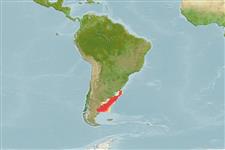>
Pleuronectiformes (Flatfishes) >
Paralichthyidae (Large-tooth flounders)
Etymology: Paralichthys: Greek, para = the side of + Greek, ichthys = fish + Greek, suffix, oides = similar to (Ref. 45335).
More on author: Jordan.
Environment: milieu / climate zone / depth range / distribution range
Ökologie
seewasser demersal; tiefenbereich 50 - 190 m (Ref. 36453), usually 70 - 100 m (Ref. 43588). Subtropical; 34°S - 47°S
Southwest Atlantic: Brazil to Argentina.
Size / Gewicht / Alter
Maturity: Lm ? range ? - ? cm
Max length : 32.0 cm TL Männchen/unbestimmt; (Ref. 43588); 38.0 cm TL (female); max. veröff. Gewicht: 456.14 g (Ref. 102462)
Kurzbeschreibung
Morphologie | Morphometrie
Rückenflossenstacheln (insgesamt): 0; Rückenflossenweichstrahlen (insgesamt): 79-92; Afterflossenstacheln 0; Afterflossenweichstrahlen: 65 - 72; Wirbelzahl: 38 - 39. Caudal fin double truncate (Ref. 27363). Almost wholly ambicolorate, the blind side is darkly pigmented except for the anterior portion of the body which has dark pigments only on the opercle, subopercle, a small region adjacent and dorsal to the head, and the distal half of the pectoral fin; two lighter pigmented areas were present on the unpigmented dorsal region of the head. The blind side had one of the 3 typical ocelli (upper one) in the same position with that of the ocular side (Ref. 34245).
Prefers hard or sandy substrates, rarely on mud (Ref. 43588). Feeds on fishes and cephalopods (Ref. 36453).
Life cycle and mating behavior
Geschlechtsreife | Fortpflanzung | Ablaichen | Eier | Fecundity | Larven
Distinct pairing (Ref. 205).
Nakamura, I., T. Inada, M. Takeda and H. Hatanaka, 1986. Important fishes trawled off Patagonia. Japan Marine Fishery Resource Research Center, Tokyo. 369 p. (Ref. 27363)
IUCN Rote Liste Status (Ref. 130435)
Bedrohung für Menschen
Harmless
Nutzung durch Menschen
Mehr Information
ReferenzenAquakulturAquakultur ProfilZuchtlinienGenetikElectrophoresesVererbbarkeitKrankheitenVerarbeitungNutrientsMass conversion
PartnerBilderStamps, Coins Misc.LauteCiguateraGeschwindigkeitSchwimmstilKiemenoberflächeOtolithsGehirngrößeSehfähigkeit
Tools
Zusatzinformationen
Download XML
Internet Quellen
Estimates based on models
Preferred temperature (Ref.
123201): 4.6 - 10.1, mean 7.9 °C (based on 82 cells).
Phylogenetic diversity index (Ref.
82804): PD
50 = 0.5000 [Uniqueness, from 0.5 = low to 2.0 = high].
Bayesian length-weight: a=0.00479 (0.00270 - 0.00849), b=3.19 (3.04 - 3.34), in cm total length, based on LWR estimates for this species & Genus-body shape (Ref.
93245).
Trophic level (Ref.
69278): 4.0 ±0.53 se; based on food items.
Widerstandsfähigkeit (Ref.
120179): hoch, Verdopplung der Population dauert weniger als 15 Monate. (Preliminary K or Fecundity.).
Fishing Vulnerability (Ref.
59153): Low to moderate vulnerability (28 of 100).
